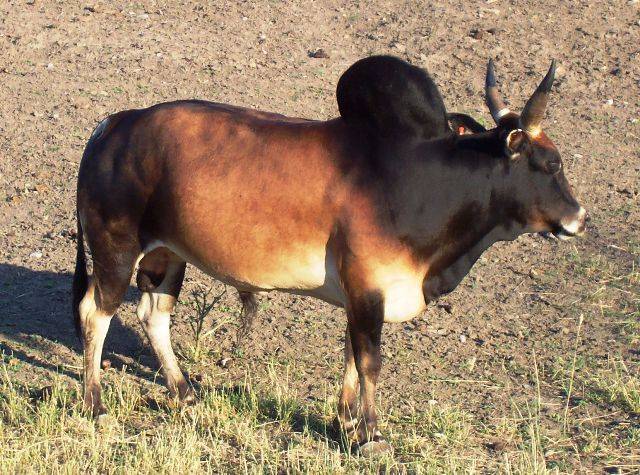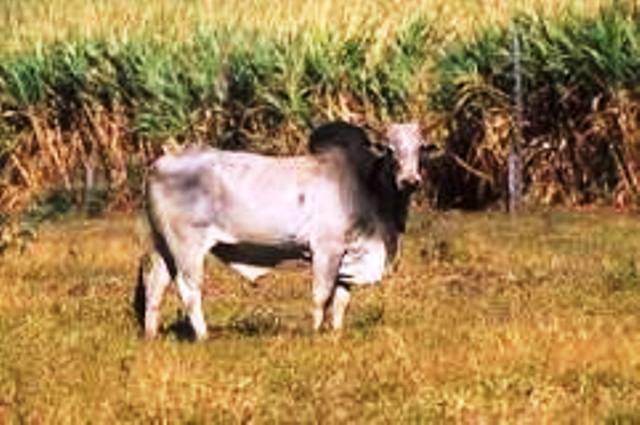
The Brazilian Association of Zebu Breeders, ABCZ, the largest livestock organization in the world, with more than 22 000 members, works as a delegate of the Ministry of Agriculture and Livestock of Brazil to carry out work on the registration and breeding of Zebu breeds. The ABCZ operates in Brazil with the Zebu Brahman, Nellore, Tabapuã, Guzerá, Gyr, Sindi, Indubrasil and Canadian breeds.
The production potential of Zebu made Brazil the largest meat exporter and a large producer of milk with high quality and in a sustainable manner. With the confidence in this potential of the Zebu and livestock of Brazil, the ABCZ together with APEX Brazil - Brazilian Export and Investment Promotion Agency, created in 2003 the Brazilian Cattle International Project, where associations, farms, semen plants and embryos participate for export of live animals, seed companies, veterinary products, equipment, machinery, nutrition, technologies and technical advice. The purpose of the Brazilian Cattle is to support the export of genetics, products and services, in order to bring increased productivity to tropical countries.

Krishi Jagran team who will be participating in the image project can learn more about Brazilian livestock and the companies that are part of the Brazilian Cattle project, as well as the EXPOZEBU 2019 FAIR, which celebrates the centenary of the ABCZ this year (2019). Apart from India, the Association ABCZ has invited Turkey, Thailand, Panama, Costa Rica, Colombia, Bolivia, United States of America and farmers from 30 different countries.
Being a part of this image project from April 26th to May 1, 2019, Krishi Jagran will do live coverage on Facebook for its viewers.
The Zebu’s Journey from India to Switzerland, via Madagascar
The zebu is a humped ox. It has descended from the ancestor of current breeds of cattle domesticated 10 000 years ago throughout the Indian peninsula. In India, Hindus regard the zebu as a sacred animal and farmers consider it an excellent worker. It is especially valued for its milk and by-products. It was then introduced to Africa, Australia, Central America and Latin America where, through a series of selections, it has now become part of the booming, intensive farming industry.
As Madagascar’s emblem and once a symbol of royalty, the zebu is part of every stage of Malagasy life. Throughout life, from birth to death, the redistribution, consumption, gift-giving and offerings of zebu meat and products are all actions which serve as a link between the living and their ancestors, between the natural and the supernatural. The zebu is also an important animal for the Fulani and the Maasai, two African ethnic groups. The size of the herd shows a family’s status.
To address global warming Swiss breeders plan to raise the number of zebu cattle in their livestock. This animal produces good quality meat, it is resistant to a large number of diseases, its milk yield does not diminish in high temperatures and it can calve even in hot weather.

Cattle that love Heat
The zebu (Bos taurus indicus L.) is a domesticated bovine adapted to tropical nations. It is a calm, passive animal which requires little care. It is valued for milk, meat, leather and horns. Its coat is usually light in colour and it has a thick, ample hide which enables it to withstand the heat. It has a dewlap to keep flies at bay and a fatty dorsal hump, which may be small or large, upright or drooping. Its curved horns, longer than those of the ox, may be black or white depending on the variety and are used in the Malagasy craft industry. A zebu’s lifespan is approximately twenty years. It belongs to the only species which can be interbred with other cattle to create new breeds.
Every Part of Zebu is precious
Zebu is the most commonly eaten meat in Madagascar. Almost every part of the animal can be eaten. Kebabs or strips of dried meat, in particular, are sold in the streets. The zebu’s hump is reportedly the best piece of meat in the world, with a similar taste to caviar or truffles.
Zebu milk is deliciously creamy and has been consumed for over 7000 years, mainly transformed into dairy products to be preserved. Kenyans use it to make ash liquid yoghurt and the Madagascans make cheese from it. Indians turn the milk into ghee a type of clarified butter.
Several nomadic and pastoral tribes use fresh zebu blood as an offering or a fortifying drink. The hides are used for making drums, the leather for rings and sandals, and shin fragments are made into hair clips and combs. The powdered bone is said to have much goodness while zebu dung is used as a fertilizer, a building material and a disinfectant.
Zebu Stealing in Madagascar: a ‘National Sport’
In Madagascar, the national sport is Savika - a kind of bullfighting with zebu. ‘Zebu stealing’ is also practised, as it was in the past. Here the robber gauges his virility according to the number of zebus he steals.
Zebu cattle originated in Southwest Asia and that their descendants were non-humped, they have evolved from three breeds of Indian cattle. The Guzerat, Nellore and the Gir had most influence over Zebu breeding. Zebu cattle are humped and belong to the Bos primigenius species of cattle. They were taken to Africa at an early date and within the last 100 years, have been exported to Brazil and the US.
It started off with small groups of this breed being taken to Brazil in the 17th and 18th Centuries where they were crossed with Brazilian cattle. These importations slowly spiked interest in cattle breeders which increased the number of larger importations. From 1890 to 1921 over 5000 Zebu cattle were exported to Brazil from India, a Rinderpest outbreak occurred which then saw a ban on importation of Indian cattle for 9 years.
During this time cross-breeding of these cattle went on, Brazilian farmers that were unsure of purebred Indian cattle used characteristics such as large ears, loose skin, the presence of a hump as an indicator of purity, both of which were common to the Gir and Guzerat, not the Nelore. This crossbreed was originally called Indu-Uberaba as it was developed in the region of Uberaba in the state of Minas Gerais but was then changed to Indu-Brazil. Rinderpest was gradually eradicated and imports were resumed and the new imports of Gir, Guzerat and Nelore were used to create pure strains of the Zebu breed.
Zebu cattle are usually red or grey in colour, are horned, have loose skin, large ears and have a hump above their shoulders. This breed is used for its milk, meat and as draft animals. In India, they are sacred and are only used for draft and milk.
In Brazil and other meat producing countries, they are produced largely for their beef as they cope better than European breeds in sub-tropical environments. Heat tolerant; Parasite and disease resistance; Hardy; Milk, Meat and Draft.
Today the Zebu is present on all continents, mainly in India and Brazil, which has the largest commercial herd in the world, with 155 million head. India has over 270 million Zebu and the US has over 2 million Zebu.















